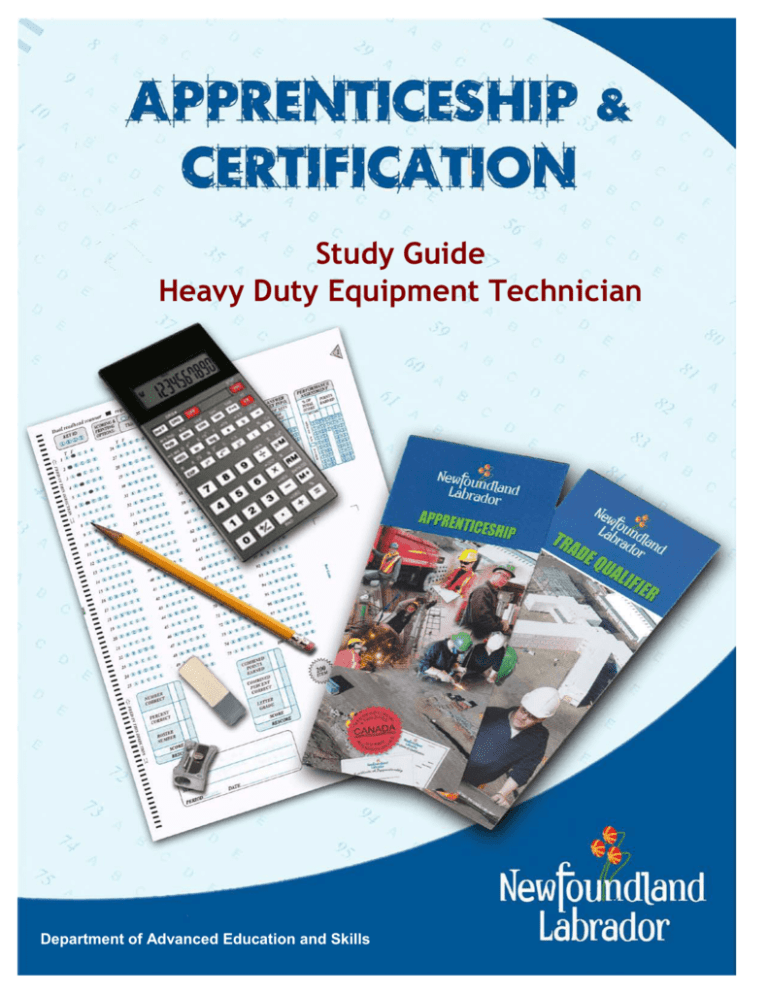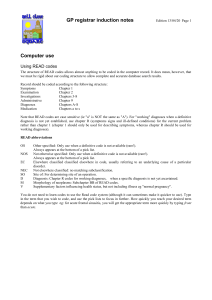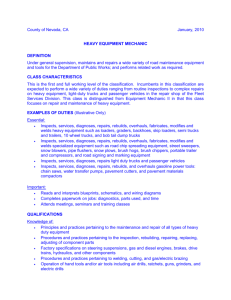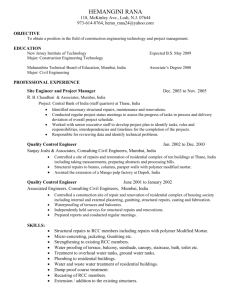Study Guide Heavy Duty Equipment Technician
advertisement

Study Guide Heavy Duty Equipment Technician Department of Advanced Education and Skills Apprenticeship and Certification Study Guide Heavy Duty Equipment Technician (Based on 2009 NOA) Government of Newfoundland and Labrador Department of Advanced Education and Skills Apprenticeship and Trades Certification Division 2011 Version 5 May 7, 2015 Table of Contents Introduction .................................................................................................................................... 3 Exam Process .................................................................................................................................. 4 Before the Exam.......................................................................................................................... 4 During the Exam.......................................................................................................................... 4 After the Exam ............................................................................................................................ 4 Exam Format ................................................................................................................................... 5 Exam Content .................................................................................................................................. 9 Understanding the National Occupational Analysis (NOA) ........................................................ 9 Exam Breakdown ...................................................................................................................... 11 NOA Sub-tasks........................................................................................................................... 12 Task Profile Checklist ................................................................................................................ 13 Create a Study Plan ....................................................................................................................... 18 Resources - Websites .................................................................................................................... 21 Resources – Book List.................................................................................................................... 22 Conclusion ..................................................................................................................................... 23 Appendices Appendix A: Regional Offices ................................................................................................ 24 Appendix B: Calculator Use ................................................................................................... 25 Appendix C: Answer Sheet Example ..................................................................................... 26 Introduction This Study Guide has been developed by the Newfoundland and Labrador Department of Advanced Education and Skills, Apprenticeship and Trades Certification Division, to assist apprentices and trade qualifiers as they prepare to write the Interprovincial (IP) Red Seal Exam. IP Exams are available for all Red Seal trades. For a list of Interprovincial trades please refer to the Department of Advanced Education and Skills website: www.ed.gov.nl.ca/app/trades.html Some of the specific goals of this guide are: to help you understand the skills and knowledge that might be covered on the exam to help you identify your strengths and weaknesses to provide organization and structure for a course of study to provide a list of resources to help you with your study plan to support and supplement the teaching and learning process This study guide outlines the theoretical portion of the program. The intent is not to replace technical training provided under the guidance of instructors. Rather, it is a tool to be used in conjunction with formal training. Study Guide_HeavyDutyEquipmentTechnician_2010 3 Exam Process Before the Exam You must contact the nearest Apprenticeship and Trades Certification Divisional office to make request to write the IP Red Seal exam (See Appendix A for a list of regional offices). Upon approval, the Program Development Officer (PDO) will notify you of your eligibility to write the exam, and provide you with scheduling information. If you require special accommodations due to a disability or language barrier, please contact your regional office for information on applying for this service. During the Exam You must bring: personal identification such as a photo or signature ID or valid Newfoundland and Labrador driver’s license your notification letter The following will be provided: a calculator (see Appendix B for calculator information) all other items required such as pencils, scrap paper, etc. Important Note: Personal cell phones, calculators, or other electronic equipment are NOT allowed into the exam room. If you do bring them, they will be stored away and returned to you when you have completed the exam. After the Exam Results will be mailed to you approximately seven to ten days after completion of the exam. All necessary instructions and information will be provided in the results letter. The percentage mark you obtained will be provided. You will also be given a section by section breakdown, showing how many questions were in each section, as well as the number of questions in each section you completed successfully. If you are successful in obtaining a 70% or more on your exam, you will be issued a Newfoundland and Labrador Certificate of Qualification with a Red Seal endorsement. 4 Study Guide_HeavyDutyEquipmentTechnician_2010 Exam Format All IP Red Seal exams are written in multiple choice format. Each exam has between 100 and 150 questions. A multiple choice question consists of a stem (a complete question) followed by four options (A, B, C, D). The stem contains all the information necessary to answer the question. The options consist of the one correct answer and three “distracters.” Distracters are incorrect. (See Appendix C for a sample answer sheet). IP Red Seal exams contain three types of questions: Level 1 Knowledge and Recall Level 2 Procedural and Application Level 3 Critical Thinking Questions at this level test your ability to recall and understand definitions, facts, and principles. Questions at this level test your ability to apply your knowledge of procedures to a new situation. Questions at this level test your ability to interpret data, solve problems and arrive at valid conclusions. Level 1 Examples: 1. What does an exhaust valve do? A. B. C. D. Allows combustion gases to escape. Allows for easier installation. Allows oil to flow freely. Allows for ring expansion. Study Guide_HeavyDutyEquipmentTechnician_2010 5 2. Why adjust crossheads after reassembling an engine? A. B. C. D. To ensure proper exhausting occurs. To ensure both valves open simultaneously. To ensure the valve seat angle is maintained. To ensure maximum power is achieved. 3. How many U-bolt clips are required for 1.5 inch diameter rope? A. B. C. D. 7. 6. 5. 4. Level 2 Examples: 1. If the flywheel to crankshaft alignment is not correct, what does it result in? A. B. C. D. Increased output horsepower. Slipping of the clutch. Excessive end play. Piston positioning being inaccurate. 2. What is the pour point, below zero of #1D winter fuel? A. B. C. D. 6 52. 44. 23. 17. Study Guide_HeavyDutyEquipmentTechnician_2010 3. M The above symbol indicates a(n)? A. B. C. D. Electric motor. Non-electric prime mover. Pneumatic pressure source. Hydraulic pressure source. Level 3 Examples: 1. A diesel engine equipped with a governor has a high idle speed of 2150 rpm and a rated speed of 1995 rpm. What is the speed droop percentage of this engine? A. B. C. D. 2.8. 7.2. 7.8. 8.7. Source of questions: trades.exambank.com 2. A diesel engine equipped with a governor has a high idle speed of 2125 rpm and a rated speed of 2075 rpm. What is the speed droop percentage of this engine? A. B. C. D. 4.3. 6.4. 0.6. 2.4. Study Guide_HeavyDutyEquipmentTechnician_2010 7 3. What should an Ohmmeter read when placed across a new fusible link? A. B. C. D. Almost zero. Infinity. 12 Volts. 24 Volts. Source of questions: www.red-seal.ca/tr.1d.2ecsdeta.3l@-eng.jsp?tid=101&fid=19 8 Study Guide_HeavyDutyEquipmentTechnician_2010 Exam Content Understanding the National Occupational Analysis (NOA) The NOA is a document used for Red Seal trades that describes the knowledge, skills and abilities required by a fully competent tradesperson working in that trade. The content for the IP Red Seal exam is based on the NOA. The NOA is an excellent tool to use as you study for the Red Seal exam. NOAs can be found at www.red-seal.ca. NOA material is organized into major content areas called BLOCKS. The blocks are further broken down into TASKS and SUB-TASKS. NOA Blocks Blocks Study Guide_HeavyDutyEquipmentTechnician_2010 Tasks Sub-tasks 9 NOA Pie Chart The NOA Pie Chart presents the block percentages in the form of a pie chart which tells you the approximate number of questions from each block. For example, 9% of the questions on the Heavy Duty Equipment Technician Exam will be based on Block A. HEAVY DUTY EQUIPMENT TECHNICIAN G 6% H 5% A 9% B 17% F 15% E 14% C 20% D 14% Block Titles Block A Block B Block C Block D 10 Common Occupational Skills Engines and Engine Support Systems Hydraulic, Hydrostatic and Pneumatic Systems Drive Train Systems Block E Block F Steering, Suspension, Brake Systems, Wheel Assemblies and Undercarriage Electrical and Vehicle Management Systems Block G Environment Control Systems Block H Structural Components, Accessories and Attachments Study Guide_HeavyDutyEquipmentTechnician_2010 Exam Breakdown The Heavy Duty Equipment Technician exam currently has 135 questions. The following table shows a breakdown of the number of questions that come from each NOA block. It is important to note that the exact number of questions can change at any time. When you are ready to write your exam, you may contact your regional office to verify the number of questions (See Appendix A). # of Questions Block A Task 1 Task 2 Task 3 Task 4 Block B Task 5 Task 6 Block C Task 7 Task 8 Block D Task 9 Task 10 Block E Task 11 Task 12 Block F Task 13 Task 14 Task 15 Task 16 Block G Task 17 Task 18 Block H Task 19 Task 20 Occupational Skills Uses and maintains tools and equipment Performs general maintenance and inspections Organizes work Performs routine trade activities Engines and Engine Support Systems Diagnoses engines and engine support Repairs engines and engine support systems Hydraulic, Hydrostatic and Pneumatic Systems Diagnoses hydraulic, hydrostatic and pneumatic systems Repairs hydraulic, hydrostatic and pneumatic systems Drive Train Systems Diagnoses drive train systems Repairs drive train systems Steering, Suspension, Brake Systems, Wheel Assemblies and Undercarriage Diagnoses steering, suspension, brake systems, wheel assemblies and undercarriage Repairs steering, suspension, brake systems, wheel assemblies and undercarriage Electrical and Vehicle Management Systems Diagnoses electrical systems Repairs electrical systems Diagnoses electronic vehicle management systems Repairs electronic vehicle management systems Environmental Control Systems Diagnoses environmental control systems Repairs environmental control systems Structural Components, Accessories and Attachments Diagnoses structural components, accessories and attachments Repairs structural components, accessories and attachments Total Study Guide_HeavyDutyEquipmentTechnician_2010 12 24 27 18 20 19 8 7 135 11 NOA Sub-tasks The following NOA Task Profile Checklist outlines the blocks, tasks and sub-tasks for your trade. The IP Red Seal exam is written to test your knowledge and abilities regarding the sub-tasks in the NOA. This chart can be used to review your current knowledge. You can review by placing a checkmark () next to those you understand fully. Place your focus on those you do not understand and study them until you are comfortable with the material. Think of possible questions in that particular content area. The NOA also contains a list of “supporting knowledge and abilities” for each sub-task. They are the skills and knowledge you must have to perform a sub-task. The supporting knowledge and abilities identified under each sub-task will be very helpful as you review. The list can be found in the NOA for your trade. 12 Study Guide_HeavyDutyEquipmentTechnician_2010 Task Profile Checklist Based on 2009 NOA Heavy Duty Equipment Technician Block A: Occupational Skills Sub-Tasks Task 1: Uses and maintains tools and equipment Maintains tools and equipment Uses hoisting and lifting equipment Operates access equipment Uses personal protective equipment (PPE) and safety equipment Sub-Tasks Task 2: Performs general maintenance and inspections Maintains fluids Services fasteners, sealing devices, adhesives and gaskets Services hoses, tubing, piping and fittings Services bearings and seals Services safety features Performs scheduled maintenance procedures Identifies operational faults Performs operational checkout Task 3: Organizes work Sub-Tasks Uses documentation and reference materials Completes documentation Communicates with others Prepares job action plan Maintains safe work environment Sub-Tasks Task 4: Performs routine trade activities Heats materials Cools materials Cuts materials Welds materials Cleans parts and materials Study Guide_HeavyDutyEquipmentTechnician_2010 13 Block B: Engines and Engine Support Systems Sub-Tasks Task 5: Diagnoses engines and engine support systems Diagnoses base engine Diagnoses lubrication systems Diagnoses cooling systems Diagnoses intake and exhaust systems Diagnoses fuel systems Diagnoses engine control systems Diagnoses emission control systems Sub-Tasks Task 6: Repairs engines and engine support systems Repairs base engines Repairs lubrication systems Repairs cooling systems Repairs intake and exhaust systems Repairs fuel systems Repairs engine control systems Repairs emission control systems Block C: Hydraulic Hydrostatic and Pneumatic Systems Task 7: Diagnoses hydraulic, hydrostatic and pneumatic systems Sub-Tasks Diagnoses hydraulic systems Diagnoses hydrostatic systems Diagnoses pneumatic systems Sub-Tasks Task 8: Repairs hydraulic, hydrostatic and pneumatic systems 14 Repairs hydraulic systems Repairs hydrostatic systems Repairs pneumatic systems Study Guide_HeavyDutyEquipmentTechnician_2010 Block D: Drive Train Systems Sub-Tasks Task 9: Diagnoses drive train systems Diagnoses clutch systems Diagnoses torque converters, fluid couplers and retarders Diagnoses driveline systems Diagnoses transmission and transfer case systems Diagnoses axle and differential systems Diagnoses final drive systems Sub-Tasks Task 10: Repairs drive train systems Repairs clutch systems Repairs torque converters, fluid couplers and retarders Repairs driveline systems Repairs transmission and transfer case systems Repairs axle and differential systems Repairs final drive systems Block E: Steering, Suspension, Brake Systems, Wheel Assemblies and Undercarriage Sub-Tasks Task 11: Diagnoses steering, suspension, brake systems, wheel assemblies and undercarriage Diagnoses steering systems Diagnoses suspension systems Diagnoses brake systems Diagnoses wheel assemblies Diagnoses undercarriage systems Sub-Tasks Task 12: Repairs steering, suspension, brake systems, wheel assemblies and undercarriage Repairs steering systems Repairs suspension systems Repairs brake systems Repairs wheel assemblies Repairs undercarriage systems Study Guide_HeavyDutyEquipmentTechnician_2010 15 Block F: Electrical and Vehicle Management Systems Sub-Tasks Task 13: Diagnoses electrical systems Diagnoses starting/charging systems and batteries Diagnoses electrical components, motors and accessories Sub-Tasks Task 14: Repairs electrical systems Repairs starting/charging systems and batteries Repairs electrical components, motors and accessories Sub-Tasks Task 15: Diagnoses electronic vehicle management systems Read diagnostic trouble codes (DTCs) Monitors parameters Interprets test results Tests system circuitry and components Sub-Tasks Task 16: Repairs electronic vehicle management systems Updates component software Repairs components Block G: Environmental Control Systems Sub-Tasks Task 17: Diagnoses environmental control systems Diagnoses heating systems Diagnoses ventilation and filtration systems Diagnoses air conditioning systems Diagnoses sound suppression systems Sub-Tasks Task 18: Repairs environmental control systems 16 Repairs heating systems Repairs ventilation and filtration systems Repairs air conditioning systems Repairs sound suppression systems Study Guide_HeavyDutyEquipmentTechnician_2010 Block H: Structural Components, Accessories and Attachments Sub-Tasks Task 19: Diagnoses structural components, accessories and attachments Diagnoses structural components Diagnoses operator station components Diagnoses attachments and accessories Sub-Tasks Task 20: Repairs structural components, accessories and attachments Performs mechanical repairs on structural components Repairs operator station components Repairs attachments and accessories Installs attachments and accessories Study Guide_HeavyDutyEquipmentTechnician_2010 17 Create a Study Plan As you prepare for your exam, it is important to plan a schedule. The following two tables will help you stay on track. The first table is a “Weekly Study Plan.” In this table list the areas you will focus your study for each day. You should include items you need to review as well as items you need to study. Remember, more time will be needed for study in areas you find difficult, whereas you may only require review in areas you are more familiar with. As you work through the NOA subtask list you can start to fill in this table. The second table is a “Study Time Table.” It is important to create a study schedule where you determine the best days of the week and times of day for you to study. Print several copies of these tables and fill out for each week of study. It is important to stick to your study schedule. 18 Study Guide_HeavyDutyEquipmentTechnician_2010 Weekly Study Plan for Week of: _________________________________________ Area of Study 1 Mon. Tues. Wed. Thu. Fri. Sat. Sun. Area of Study 2 Area of Study 3 Area of Study 4 Area of Study 5 Area of Study 6 Study Time Table for Week of: _________________________________________ Monday 8:00 AM 9:00 AM 9:00 AM 10:00 AM 10:00 AM 11:00 AM 11:00 AM 12:00 Noon 12:00 Noon 1:00 PM 1:00 PM 2:00 PM 2:00 PM 3:00 PM 3:00 PM 4:00 PM 4:00 PM 5:00 PM 5:00 PM 6:00 PM 6:00 PM 7:00 PM 7:00 PM 8:00 PM Tuesday Wednesday Thursday Friday Saturday Sunday Resources - Websites Study information can be drawn from a variety of sources. A sample list of study materials (websites and books) is provided below. These and other helpful resources may be found in a local college bookstore, on the internet, or at your place of employment. You may also be able to borrow them from an apprentice or journeyperson in your trade. Study Strategies and Exam Preparation Guide The Study Strategies & Exam Preparation Guide is meant to be used in conjunction with this study guide. It provides direction and information on such areas as study habits, test preparation and test taking techniques. Exam Preparation Guide: www.ed.gov.nl.ca/app/publications/exam_prep_guide.pdf Plan of Training (POT) A Provincial Plan of Training details the full scope of learning for a particular occupation, including both technical training competencies and industry experiences necessary to write an IP Red Seal exam (and complete the requirements for Red Seal Certification), or to write a provincial examination. The Plan of Training is based on the NOA. POT Website: www.ed.gov.nl.ca/app/plans.html Red Seal Website National Occupational Analysis - The NOA is a document used for Red Seal trades that describes the knowledge and abilities required by a fully competent tradesperson working in that trade. The content for the IP exam is based on the NOA. Red Seal Website: www.red-seal.ca Heavy Duty Equipment Technician PRACTICE Exam This is NOT an IP exam. This is a practice exam provided by the Inter-provincial Standards Red Seal program. It was developed using similar question types to that of a Red Seal exam. The exam is intended to be used for self-assessment in preparation for writing an IP Exam. Sample questions can be found at: www.red-seal.ca/tr.1d.2ecsdeta.3l@-eng.jsp?tid=101&fid=19 Glossary of Terms The Red Seal website also lists a Glossary of Terms which will be helpful in preparing for your IP exam: www.red-seal.ca/tr.1d.2n.4adeta.3l@-eng.jsp?tid=101&fid=168 Study Guide_HeavyDutyEquipmentTechnician_2010 21 Resources – Book List The books listed below are sorted according to NOA blocks as referenced throughout this study guide. You can use this list to help you obtain information on specific topics. It is not necessary to use these books specifically, as you may find others that will be equally beneficial. BLOCK BOOK A B C D E Modern Diesel Technology (MDT): Electricity and Electronics MDT: Diesel Engines F G H MDT: Brakes, Steering and Suspension Systems MDT: Electronic Diesel Engine Diagnosis MDT: Heating, Ventilation, Air Conditioning and Refrigeration MDT: Heavy Equipment Systems th Diesel Mechanics, 4 edition Medium/Heavy Duty Truck Engines, Fuel & Computerized rd Management Systems, 3 edition Canadian Truck and Transport Technician: Inter-provincial Certificate of Qualification Test Preparation If you wish to obtain any of the resources listed above, here is the reference information: Modern Diesel Technology: Electricity and Electronics, Delmar Gengage Learning, Bennett, ISBN 22 1-4018-801304 Modern Diesel Technology: Diesel Engines, Delmar Gengage Learning, Spears, ISBN 1-40189809-2 Modern Diesel Technology: Brakes, Steering and Suspension Systems, Delmar Gengage Learning, Bennett, ISBN 1-4180-1372-2 Modern Diesel Technology: Electronic Diesel Engine Diagnosis, Delmar Gengage Learning, Bennett, ISBN 1-4018-7079-1 Modern Diesel Technology: Heating, Ventilation, Air Conditioning and Refrigeration, Delmar Gengage Learning, Dixon, ISBN 1-4018-7849-0 Modern Diesel Technology: Heavy Equipment Systems, Delmar Gengage Learning, 2009, Bennett, Huzij and Spano, ISBN 1-4180-0950-4 Diesel Mechanics, 4th edition, McGraw-Hill, 1999, Evridge and Schulz, ISBN 0-02-803462-7 Medium/Heavy Duty Truck Engines, Fuel & Computerized Management Systems, 3rd edition, Delmar Gengage Learning, 2009, Bennett, ISBN 1-4283-6666-0 Canadian Truck and Transport Technician: Interprovincial Certificate of Qualification Test Preparation, Centennial College Press, 2003, Bennett, Parsons and Restoule, ISBN 0-91985244-0 ** (85% of the Heavy Duty content is covered here). Study Guide_HeavyDutyEquipmentTechnician_2010 Disclaimer Various external resources (websites, textbooks) have been listed in this study guide to assist an individual in preparing to write an IP Red Seal Exam. This does not mean the Department of Advanced Education and Skills, Newfoundland and Labrador endorses the material or that these are recommended as the best resources. There may be other resources of equal or greater value to an individual preparing for an IP Red Seal exam. The Department of Advanced Education and Skills has no control over the content of external textbooks and websites listed, and no responsibility is assumed for the accuracy of the material. Conclusion We hope this guide has provided you with some useful tools as you prepare for your IP Red Seal exam. If you have any questions regarding your IP Red Seal exam please contact your regional office (see Appendix A for a list of regional offices). We appreciate your comments and feedback regarding the usefulness of this study guide. If you have any comments or suggestions, we welcome your feedback. The feedback form at the end of this guide can be used for this purpose. Study Guide_HeavyDutyEquipmentTechnician_2010 23 Appendix A: Regional Offices If you have any questions regarding your IP Red Seal exam, please contact one of the following regional offices: Department of Advanced Education and Skills Apprenticeship and Trades Certification Division Toll Free: 1-877-771-3737 www.ed.gov.nl.ca/app/ Corner Brook Grand Falls-Windsor 1-3 Union Street Aylward Building, 2nd Floor Corner Brook, NL A2H 5M7 42 Hardy Avenue Grand Falls-Windsor, NL A2A 2J9 Telephone: Facsimile: Telephone: Facsimile: (709) 637-2366 (709) 637-2519 Clarenville (709) 292-4215 (709) 292-4502 St. John’s 45 Tilley’s Road Clarenville, NL A5A 1Z4 P.O. Box 8700 1170 Topsail Road Mount Pearl, NL A1B 4J6 Telephone: Facsimile: Telephone: Facsimile: (709) 466-3982 (709) 466-3987 (709) 729-2729 (709) 729-5878 Happy Valley – Goose Bay 163 Hamilton River Road Bursey Building Happy Valley – Goose Bay, NL A0P 1E0 Telephone: Facsimile: 24 (709) 896-6348 (709) 896-3733 Study Guide_HeavyDutyEquipmentTechnician_2010 Appendix B: Calculator Use The picture below shows a calculator with the same functions as the one you will be provided with during your exam. It is advisable to borrow or purchase one with similar functions so that you can familiarize yourself with it before you write your exam. Study Guide_HeavyDutyEquipmentTechnician_2010 25 Appendix C: Answer Sheet Example With your exam you will be given an answer sheet similar to the one below. When answering multiple choice questions be sure to fill the circle completely and fill the circle that corresponds to the question on the exam. 26 Study Guide_HeavyDutyEquipmentTechnician_2010 Feedback Form Study Guide – Heavy Duty Equipment Technician Please answer the following: (1) This Study Guide is a useful tool for exam preparation. strongly agree agree disagree strongly disagree (2) The topics contained in the guide are arranged in a logical order. strongly agree agree disagree strongly disagree (3) The design and format of the guide caught my attention. strongly agree agree disagree strongly disagree (4) The instructions throughout the guide are clear and to the point. strongly agree agree disagree strongly disagree (5) The resources listed in this guide are suitable and valuable. strongly agree agree disagree strongly disagree (6) The guide should contain more information. strongly agree agree disagree strongly disagree Suggested information/resources to include: Additional Comments: Please complete this form and return via fax or mail to the following: Department of Advanced Education and Skills Apprenticeship and Trades Certification Education Standards and Curriculum Unit 45 Tilley’s Road, Clarenville, NL A5A 1Z4 Fax: (709) 466-3987





